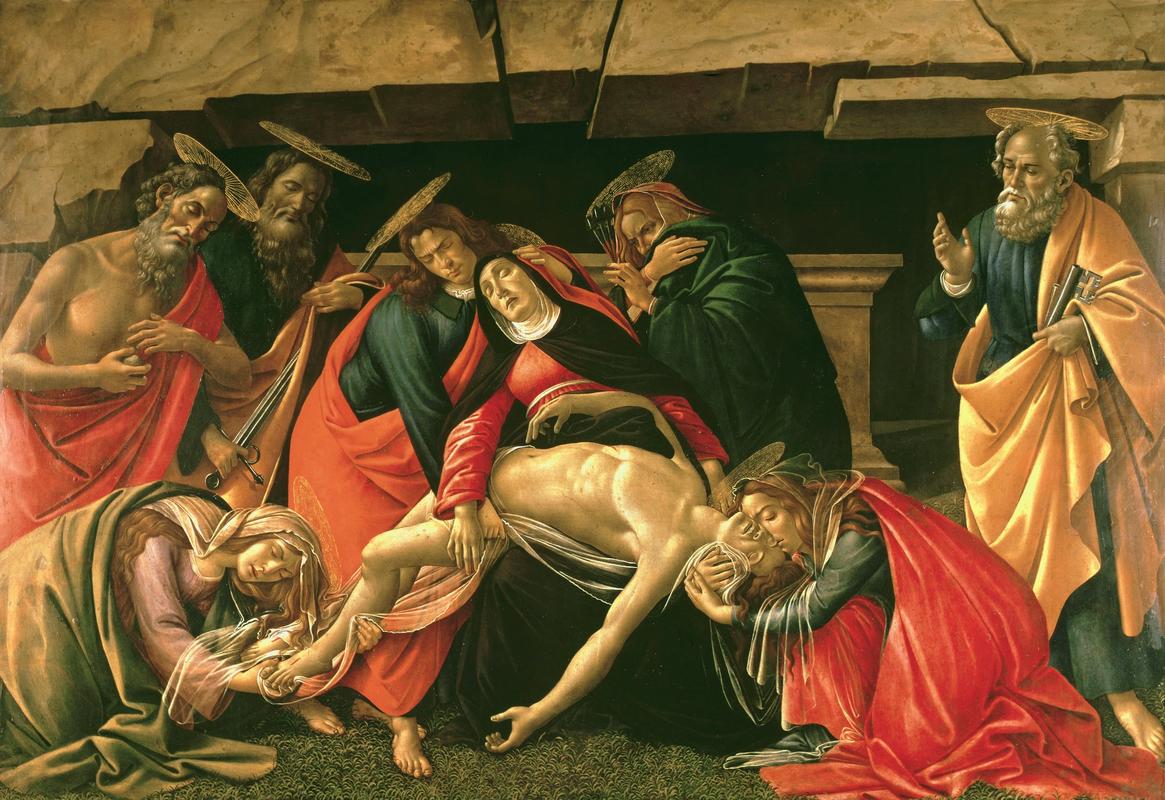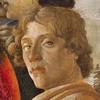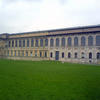More about Lamentation over the Dead Christ

Contributor
The German Abendzeitung news site headlines an article about Botticelli's Lamentation over the Dead Christ "In the riot of color in the sepulcher."
As with his Birth of Venus, in Lamentation Botticelli shows off his love of loud, flashy colors, but somehow their brightness does not put a damper on the tone of extreme sadness. One thing that the 'color riot' of red and orange robes accomplishes is that it highlights the nudity and emptiness of Christ's lifeless cadaver.
When you go on a rampage of conquering and pillaging, it's always helpful to enlist the help of local people. That's just what Napoleon did in Firenze when he chose Michele Mazzoni to make him a nice "shopping list" of devotional artworks in the closed monasteries. Mazzoni wasn't about to let a good business opportunity go to waste, so he set his sights on the San Paolino church where he saw a dirty, but excellently rendered painting hanging above the fireplace. Figuring it could be a fixer-upper, he bought it. Then he noticed this Botticelli work on the high altar of the San Paolino. "That one's too good for Napoleon," he said to himself. Mazzoni slyly managed to stay below Napoleon's radar, hiding this work in his stable with the horses for a year.
The horses suggested that he hire Luigi Scotti, one of the best restorers in the city, to take care of all the dust and woodworm. Scotti added a lot of his own artistic flair, which wasn't corrected until recently, but his work nevertheless get the attention of Ludwig I, the King of Bavaria, who added it to the Munich art collection that eventually became part of the Pinakothek. The Oetker Foundation financed the recent extensive restoration of this work, supported by curator Andreas Schumacher.
Botticelli did another version of this scene, which resides in Milan. In order to distinguish this piece from that one, Emile Gebhart and Victoria Charles call it the Lamentation of the Dead Christ with Saints Jerome, Paul and Peter (Pietà).
Sources
- Frascati-Lochhead, Marta. Kenosis and Feminist Theology: The Challenge of Gianni Vattimo. Albany, NY: SUNY Press, 1998.
- Gebhart, Emile, and Victoria Charles. Botticelli. London: Parkstone, 2015.
- Kanter, Laurence B., Hilliard T. Goldfarb, and James Hankins. Botticelli's Witness: Changing Style in a Changing Florence. Boston: Gardner Museum, 1997.
- Pinakotheken. "#Kunstminute | Andreas Schumacher: Sandro Botticelli, Beweinung Christi." YouTube Video, 1:00, May 20, 2019, https://m.youtube.com/watch?v=FN9MZCOVu5Q.
- Salvini, Roberto. All the Paintings of Botticelli, Part 4. New York: Hawthorn, 1965.
- Schumacher, Andreas. "Botticelli in Neuem Licht." Weltkunst, Apr. 10, 2017, https://www.weltkunst.de/kunstwissen/2017/10/botticelli-in-neuem-licht.
- Sigg, Christa. "Alte Pinakothek: Im Farbrausch am Grab." Abendzeitung, Apr. 10, 2017, https://www.abendzeitung-muenchen.de/inhalt.sandro-botticellis-beweinun….
Featured Content
Here is what Wikipedia says about Lamentation over the Dead Christ (Botticelli, Munich)
The Lamentation over the Dead Christ is a painting created by Sandro Botticelli. Botticelli was an Italian painter who was active in Florence, Italy and his works represent the late Italian Gothic and Renaissance periods. Some of his notable works include Primavera and The Birth of Venus.
Botticelli was the apprentice of Filippo Lippi one of the leading Florentine painters of the time. In 1481, Botticelli completed some works for the Sistine Chapel; during the 1480s, he also completed works depicting mythological subjects. Botticelli became associated with the Florentine School under the patronage of Lorenzo de' Medici an era historians characterize as a golden age. The painter also completed portraits and manuscripts.
The Lamentation of Christ is part of the cycle of the Life of Christ. After Jesus was crucified his remains were removed from the cross and his friends mourned over his body. One specific type of Lamentation depicts the Virgin Mary cradling the body of Christ; popularly known as the Pietà (Italian for "pity"). The subject of the Lamentation of Christ has been painted since the inception of Christianity and it was a common subject of Italian Renaissance painters. Botticelli completed another version entitled Lamentation over the Dead Christ between 1490 and 1495. The current painting was completed around the same period between 1490 and 1492. It is now in the Alte Pinakothek, in Munich.
The portrait shows the inert body of Christ surrounded by the Virgin, St. Peter, and Mary Magdalene, St. John the Evangelist, St. Jerome and St. Paul.
The sad expressions of the characters were a novelty in Botticelli's art: under the spiritual influence of Savonarola's preachings in Florence, which began around the time the work was executed, he started in fact to abandon the allegoric inspiration that had made him a favorite of the Medici court in favor of more intimate and painstaking religious reflection.
Check out the full Wikipedia article about Lamentation over the Dead Christ (Botticelli, Munich)














